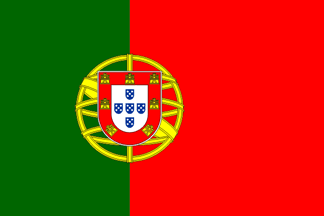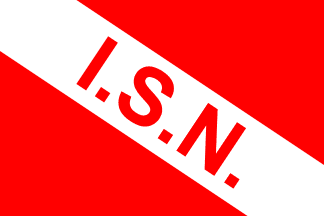 klaus-michael schneider
klaus-michael schneider
Keywords: beach | beach awards | environment |
Links: FOTW homepage | search | disclaimer and copyright | write us | mirrors

Last modified: 2024-11-23 by  klaus-michael schneider
klaus-michael schneider
Keywords: beach | beach awards | environment |
Links: FOTW homepage |
search |
disclaimer and copyright |
write us |
mirrors

The Portuguese system in beach security is a “traffic light” system where the flags’ significance is as follows:
Jorge Candeias, 28 June 2005

You can bath and swim, provided you follow the security rules as set and made public annually by the I.S.N. This flag is hoisted with fair sea conditions.
Jorge Candeias, 28 June 2005

You can bath but you cannot swim. This flag is hoisted when there are strong currents due to the danger of people being dragged away by the sea.
Jorge Candeias, 28 June 2005

You cannot bath, i.e., you cannot enter the water. This flag is hoisted when there are exceptionally strong currents, in the presence of big waves, when sharks are detected in the area (in the archipelagos, most of all — sharks are very rare in mainland Portugal), when hydrocarbons are spilled or toxins are found in the water, when explosives are detected in the sand or in nearby waters, during military exercises with amphibious landings, when the maritime authorities so command, and so on. From my experience, of all these cases, the most common situation of red flag are big waves.
Jorge Candeias, 28 June 2005

The lifeguard is temporarily absent from the beach. Usually this flag gets up on the mast during lunch hours. Regarding the precise arrangement of squares, weather it’s blue and white or white and blue it’s pretty much irrelevant (i.e.: the flag cannot be hoisted upside down) — what matters is the pattern.
Jorge Candeias, 28 June 2005

It is red with a white descending diagonal (starting from the top hoist) bearing the organisation’s initials, plus dots, also in red. More info in this page.
Jan Mertens, 27 June 2005
It is one of the best-known flags in Portugal, a red and white diagonal triband, based on the “diver down” flag, with the institute’s initials, in red, in the white band. The I.S.N. (Instituto de Socorro a Náufragos, literally tranlatable as «Institute for Help to Castaways») is an organism
that depends from the Portuguese Navy, and whose purpose is to maintain beach and maritime security. It’s the I.S.N., which coordinates rescue operations in high sea and it’s the institute that provides beach surveillance and security.
It has a site which is subsite to the Navy’s website, and includes plenty of information, although only in Portuguese.
I.S.N. has a coat of arms (shown in this page).
Jorge Candeias, 28 June 2005

Bandeira dourada (golden flag) is an award given yearly to beaches that pursue correct environmental practices, such as care for dune integrity, beach facility sewage and garbage disposal, Nature conservancy etc.
Jorge Candeias, 6 Mar 2002
![[Accessible Beaches Award flag (PT)]](../images/p/pt~acsv.gif) 2:3, image by António Martins-Tuválkin, 9 Nov 2024
2:3, image by António Martins-Tuválkin, 9 Nov 2024
The Portuguese beach accessibility program, Programa Praia Acessível - Praia para Todos!_("Accessible beach: beach for all!"), was created in
2005 by three governmental non-ministerial entities (Turismo de Portugal, I.P._, Agência Portuguesa do Ambiente, I.P._, and Instituto Nacional para a Reabilitação, I.P._). As of August 2021.08 it recognises as such 201 beaches in the country.
According to the program's 2020 guide list (August 2021 update) this webpage, a distinctive flag is to be used as a marker to signal a beach entrance devoided of architectural barriers for wheelchair access. The document itself doesn´t describe the flag, only mentions it, "Entrada na praia sem barreiras arquitetónicas, assinalada pela Bandeira Praia Acessível;" (p.2), and the logo on its cover matches a "logo on bedsheet" flag that can be seen in many beaches in Portugal during the summer season. It seems to be used as yet another award flag, though, hoisted among other flags in flag pole rows, not necessarily (or effectively) signaling a step-free access.
It is a ~2:3 white flag with the program´s logo over all; the logo consists of a pictogram and lettering; the pictogram is set within a square with round corners, its limit mostly blending with the white background; it shows a wheelchair icon (classic style) in blue against a background symbolising the seashore on the right side (i.e., in front of
the human figure), solid blue over white separated by three wavy lines and a sun disc, and on the left (back of the human figure), the sun disc taking the place of the chair´s wheel (!) with five amber sunbeams of increasing size, radiating from the back of the human figure (!). At the lower right side of pictogram (i.e. at the lower hoist of the visible flag obverse), the phrase "praia acessível" in blue blocky serifless lower case letters and below both, smaller in the same typeface, the motto "praıa para todos", spelling sic, no punctuation. The reverse is not mirrorred and is therefore illegible. Attached as [pt~acsv.gif].
Some examples of its use are here and here
António Martins-Tuválkin, 9 Nov 2024
![[Praia com Qualidade de Ouro]](../images/p/pt~qau.gif) image by António Martins-Tuválkin, 27 Dec 2023 |
![[Praia com Qualidade de Ouro old]](../images/p/pt~qau0.gif) image by António Martins-Tuválkin, 27 Dec 2023 |
"Praia com Qualidade de Ouro" is a yearly awarded beach quality accreditation issued by Quercus, a Portuguese environmentalist NGO. It is directed to beaches located in Portugal (including river and lake beaches) and results of a multi-year aggregate of publicly available metrics on several aspects beach quality (safety, accesibility,sustainability, and public health) and managers of awarded beachs are entitled to display locally the flag issued that same year for that purpose. The municipal government in charge or each beach seems to be envolved in the application and accreditation process, and there are what seem to be regional sponsors (namely water and sewage utilities), but I couldn´t find reliable documentation.
The official website of Quercus gathers info pertaining this campaign at, apparently lacking a centralised presentation page or other document. The yearly awarding dates back to 2004 and the flag is in existence since at least 2011.
There is a basic design onto which the year number is added on the upper fly and, optionally, varying sponsor logos may be added to the lower fly (examples to follow), above the name of the award and the organiser´s logo. The basic design shows a light teal-blue and white wave, facing the hoist, on a golden yellow background (high contrast against the white areas). Minor details were introduced sometime between 2020 and 2023, especially the Quercus logo, which changed from pictogram only (an oak leave between brackets) to pictogram with additional lettering because of course it did. The over all ratio is less oblong than usual for flags in Portugal, at around 12:17 (likely to match a prescription for 60×85 cm²). The main text is apparently set in a typeface named Clobber Grotesk Bold; see here
The current (see left image above) and hte previous (see right image above) are just the flag design templates without year of award.
![[golden bech quality 2023]](../images/p/pt~qau23.gif) image by António Martins-Tuválkin, 31 Dec 2024 |
![[golden bech quality 2020]](../images/p/pt~qau20.gif) image by António Martins-Tuválkin, 31 Dec 2024 |
![[golden bech quality 2017]](../images/p/pt~qau17.gif) image by António Martins-Tuválkin, 31 Dec 2024 |
Here are examples for annual flags as follows,illustrating the current model (see left image above), for 2023, based on Quercus; illustrating the previous model (see central image above), for 2020, based on this photo, another previous more oblong model (see right image above), as e.g. depicted in the municipal webpage of Póvoa do Varzim here
António Martins-Tuválkin, 31 Dec 2024
I could not find information about the part of the accreditation process that covers the aquisition of the actual flag for each awarded beach. The exact specs seem to vary and even flag makers/retailers seem to have their own versions, I noticed that more oblong versions especially abound, with some of the bottom cropped off (I suspect fraying and/or unwillingness to show the sponsors logo), which is readily visible on the complex wavy pattern of that area of some flags.
Guessing from this official municipal website, it seems that this award and Praias Douradas are two separate awards after all, listing all licensed beaches of Viana do Castelo, where these two are listed separately — although the way dog friendly beaches are indicated suggests that the concept of a x;y table is too sophisticated for whoever design this list. Since the only two beaches awarded as Praia Dourada are mot marked as having been also awarded as Praia com Qualidade de Ouro, it may till be that this is the same award after a name change.
António Martins-Tuválkin, 14 Mar 2024
back to Portuguese Flags for Use at Sea click here